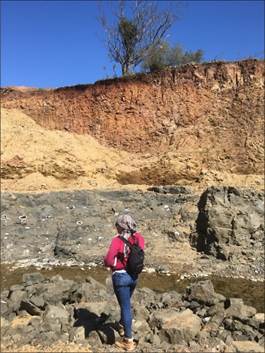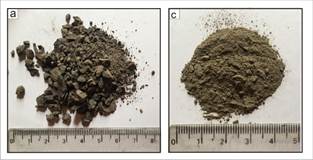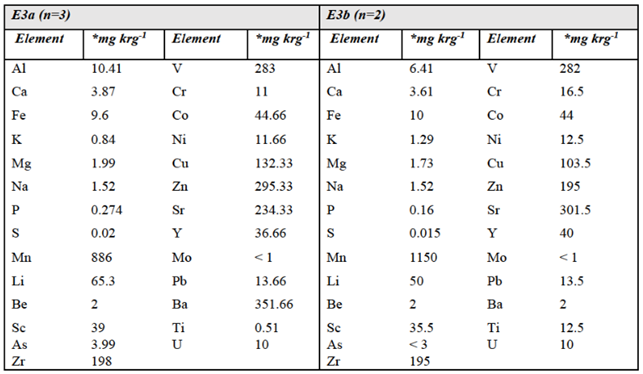1. Introduction
The technique known as rochagem, stonemeal or rocks of crops consists of the addition of rock dust to increase the soil fertility conditions, considering rocks as natural sources of a series of macronutrients and micronutrients essential for plant nutrition1)(2)(3. This technique has been developed for several decades in some African countries4, in Australia5)(6)(7)(8) and in Brazil, using different types of local lithologies as natural sources of agrominerals. Defining agrominerals as the raw material of mineral origin for the production of soil conditioners or fertilizers for agricultural use, which comes from geological resources and was subject to industrial processing before becoming a product9.
Agricultural institutions such as EMBRAPA (Empresa Brasileira de Pesquisa Agropecuária) have been promoting research on this subject since the beginning of the 2000s, specifically in identifying, characterizing and evaluating the agronomic and economic potential of the use of various agrominerals derived from silicate rocks. In 2013, after many years of exchange between public and private institutions, with the creation of a working group to standardize the use of rock dust (remineralizers) for agriculture, consisting of MAPA, MME, MCTI, EMBRAPA, MADER/UnB, DNPM and CPRM, the insertion of remineralizers and plant extracts as input categories that can be used in agriculture was approved by the National Congress of Brazil and sanctioned by the Law of the Republic 12.89010) of December 10, 2013, which modifies the Fertilizers Law (Law 6.894, of December 16, 1980)11. This Law, in article 3, defines the remineralizer as any material of mineral origin that has only suffered size reduction and classification by mechanical processes and that changes soil fertility rates by adding macro and micronutrients for plants, as well as promoting improvements in the physical or physicochemical properties or biological activity of the soil. In 2018, the Brazilian Geological Service and the Mineral Research Center (SGB/CPRM) presented the Agrogeological Zone of Brazil map, scale 1:1,000,000, in which they integrated the consumption and the occurrence of agrominerals applicable to the management of soil fertility in the same cartographic database12.
In countries where the technique of stonemeal or rochagem is developed, sterile material is mainly used as raw material, that is, that which has no economic value in the mining activity, after going through a benefication process. Beneficiation meaning all operations that, from the rock or crude mineral, concentrate the raw material using mining, physical preparation, concentration, and agglomeration methods to which the extracted mineral is subjected for its subsequent use or transformation. Except for the use of the best-known agrominerals, such as gypsum, calcium carbonate, and phosphates, used as fertilizers and conditioners in traditional agriculture, this technique of exploiting mining waste as a source of agrominerals has been scarcely studied in Uruguay so far. This study presents preliminary studies on the potential use of residual basalt rock dust from agate and amethyst mining activity in Uruguay as a source of agrominerals.
Mining activity in Uruguay, and specifically the exploitation of agates and amethysts in the department of Artigas, has remained constant since the 70s. In 2014, Law 19.23813 declared the city of Artigas as the national capital of precious and semi-precious stones (amethysts and agates) due to the concentrations of these stones, located in the valley and the entire basin of the Catalan stream. This type of mining venture has a lifespan of approximately 30 years, with the material of economic interest being the mineralized levels where the geodes (cavities) are located containing the mineral with commercial value, agates, and amethysts; the rest is waste, which is finally disposed of in the surroundings, in a specific sector and planned from the beginning of the exploitation.
The material of the slag heap is fragmented in variable sizes, arranged in outdoor piles, where it is easily disaggregated over time due to the action of the water. It is common for the ratio of generated rock waste to ore to be greater than 1, implying that more rock waste is produced than exploited material, becoming a problem due to its final disposal and environmental management.
Regarding the history of the use of basalt dust in the region, mineralogical and geochemical studies have been carried out in the Serra Geral Formation14)(15) in the southern region of Brazil, focused on the feasibility of using these lithologies as a source of macro and micronutrients (K, Ca, Mg, Fe, Zn) in the soil4. From the analysis of the composition and the data obtained from leaching, it is concluded that basalt dust has potential as a source of macro and micronutrients. It also highlights the low solubility of the material as an advantage in reducing leaching and fixation losses, which would allow its use as a source of nutrients in the long term due to the slow release. Some papers report successful experiences of using rock dust as an amendment to improve soil and crop nutrition16)(17)(18)(19)(20. The low solubility of rock dust is also considered to allow the plant to use nutrients as it grows20)(21)(22. The fact that it is absorbed slowly and for a longer period could enable the recomposition of fertility and ensure a better balance in the soils.
The use of rock dust as a fertilizer can help reduce costs in agricultural production and contribute to the waste management from mining activity, giving added value to a discarded product without value23)(24)(25)(26.
To conclude, we can affirm that the dual function of agrominerals as conditioners and fertilizers providing macro and micronutrients presents them as an interesting alternative to the use of conventional fertilizers. In addition, it adds the possibility of the combined use with organic amendments of residues from other agricultural activities, as well as providing possible solutions to the environmental management of mining activity. In countries of the region such as Chile, with an important mining tradition, environmental management plans focused on the circular economy linked to the treatment of mining waste have been underway for a few years. In an article published in 2017 by the Chilean journal Ecosistemas Enred, the authors Moguillansky and Echeverría27 propose that the only alternative to manage the environmental costs and benefits of mining activity is to transform waste into resources by supporting new technologies, new processes and cooperation between the actors involved. They emphasize that this approach can be felt as an additional cost at first, but in the long term, it is a guarantee of the sustainability of the activity. The concept of circular economy in mining would apply very well to the proposal of the production of raw material for agrominerals from waste material from the extraction of agates and amethysts in Uruguay, which comply with international trade standards.
1.1 Location and geology of the study area
The study area for this research is located in the area known as the Gemological District Los Catalanes, linked to the exploitation of agates and amethysts, in the active, open-pit quarry of the firm Urumining S. A. (Fig. 1). From a geological point of view, the lithologies corresponding to Los Catalanes Formation of the Arapey Group emerge in the study area28. This is defined by a succession of basaltic spills among which sheets and barchans (crescent-shaped dunes) of wind sands were deposited, currently silicified29. The Arapey basaltic block of the Lower Cretaceous age constitutes the most important stratigraphic unit with an outcropping surface of 41000 km2 and up to 900 m thick.
The most characteristic rocks are massive basalts of fine grain and dark colors. The geochemical data for this unit establish two types of basalt: with low content of Ti and P, that are located in the south of the basaltic province of the Paraná Basin, and the basalts with high Ti and P, that appear in the northern zone of the same province, which lie on those of the south. It is also mentioned that some cases present crustal contamination, but most of the magmas derive from lithospheric mantle enriched in trace elements29.
In the area of the quarry surveyed, the casting 3 is recognized and defined as a mineralization carrier according to the report of DINAMIGE30, which is characterized by emerging in the valleys of watercourses, in this case in the Zanja de Los Talas canyon, below the level of 200 m. The average level and the casting cap described in the report are recognized in the study area. The report also defines the mean level as a fine-grained basalt, steel-gray color, and very irregular fracturing in both spacing and orientation30. A macrovesicular level is usually developed in the upper part, which presents a very good quality of mineralization and lateral continuity in some sectors, reaching up to 8 m of power. It is common for this mineralized level to be structured in two levels that can appear in the same profile, being (a) the lower level formed by massive to massive vesicular basalt, greenish-gray and with localized hydrothermal alteration, and (b) upper-level vesicular basalt, brown with strong meteoric alteration (Fig.1).
2. Material and methods
For this work, three areas of dumps were surveyed with a total of 10 samples:
Slag heap 1 (E1). It is located in the quarry surroundings and is identified as the sector where the oldest piles of material are located. Rock fragments range from whole, fractured, centimeter-sized loose geodes to levels of fine, highly weathered vacuolar basalt that breaks up very easily with gray to reddish-brown colorations. In some sectors, it is covered by vegetation (Fig. 2a).
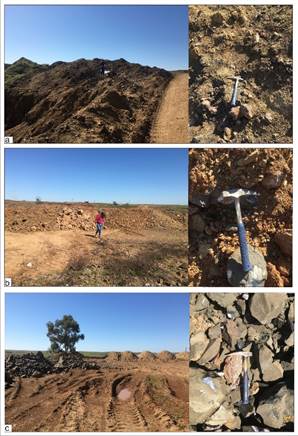
Figure 2: Panoramic view of the slag heaps and detail of the sampled material: (a) Slag heap 1, (b) Slag heap 2, (c) Slag heap 3
Slag heap 2 (E2). Material composed mainly of levels of vacuolar basalt, with reddish-brown colorations, less altered than the material sampled in the E1 piles, but also breaks up easily. Fragments of geodes ranging from 20 cm to mm are observed (Fig. 2b).
Slag heap 3. Two sectors called E3a and E3b were sampled. The E3a samples represent the piles of material recently removed from the vacuolar basalt level with economic interest. They are metric-size fragments, from gray to brown, and present mineralized vacuoles. The E3b samples are from the same level, but more altered, where reddish-brown colorations predominate (Fig. 2c).
The area of each of the slag heaps was surveyed, the homogeneity of the material in each of them was observed and a random subsurface sampling was carried out (10 cm deep), with each sample weighing approximately 5 kg. Samples were ground and sieved in the geology laboratories of the University Development Pole of Geology and Mineral Resources of the CURE at the headquarters in Treinta y Tres. A Retsch RS 200 jaw and fine mill were used for coarse grinding (Fig. 3). Then it was passed through the Retsch AS 200 sieve to achieve the necessary granulometry (<125 microns) to perform geochemical analyses at the international ACTLABS laboratory (Ancaster, Canada).
The analytical technique performed was Fluorescence X-ray to determine the percentage by weight of the oxides present, such as SiO2, Al2O3, Fe2O3, MnO, MgO, CaO, N2O, K2O, TiO2, and P2O5.
The Emission Spectrometry method by inductively coupled plasma (ICP-OES) was used to quantify the presence of major, minor and trace elements (Cr, Co, Ni, Cu, Zn, As, Se, Cd, Sb, Hg, Ti and Pb).
3. Results and discussion
The analyzed samples yielded the following results:
Slag heap 1 (E1). Four samples were analyzed and the results obtained by the FRX method (Table 1a) determined the SiO2 as the main component, followed by the Fe2O3, and in a smaller proportion the oxides of CaO, MgO Na2O, TiO2, K2O, and finally P2O5. ICP results show average values of potentially toxic elements such as As and Cd less than 3 mg krg-1 and Pb around 15 mg krg-1. The high content of Mn, Ba, Sr, V, Zn and Zr is highlighted (Table 1b).
Slag heap 2 (E2). The results of the FRX analyses for this slag heap correspond to a sample that presents SiO2 as the main oxide, followed by Al2O3, and the oxides MgO, CaO, TiO2 and K2O are present in a lower proportion. ICP results show average values of potentially toxic elements such as As and Cd lower than 3 mg krg-1, and Pb around 7 mg krg-1. The high content of Mn, Ba, Sr, Zr, Zn y Cu is highlighted (Table 2).
Table 1: Chemical analysis by RX fluorescence. Average values (*) and standard deviation (S.D) of oxides present in slag heaps E1, E2 and E3 (a,b)

Table 2: Mean values (*) of minor and trace elements obtained by ICP - OES from slag heaps E1 and E2
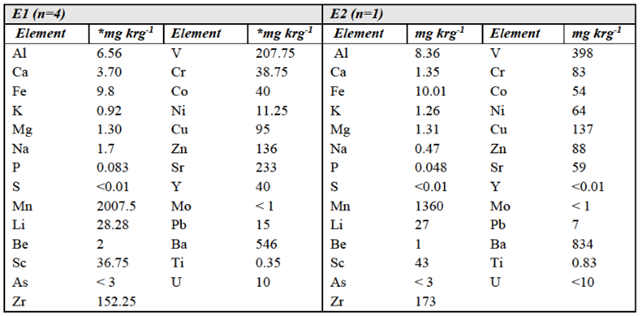
Slag heap 3 (E3a and E3b). Regarding the E3a material, the FRX results for the three samples analyzed show a high content of oxides SiO2, followed by oxide Al2O3 and Fe2O3. In a lower proportion, CaO oxide, MgO, Na2O, TiO2 and MnO. From the potentially toxic elements, average values of 6 mg krg-1 were obtained for As in a sample and lower than 3 mg krg-1 for the rest, the same occurred for Cd. For Pb, values around 14 mg krg-1 were obtained. High values are highlighted of Mn, Ba, V, Zr, Zn, Cu, and in a lower proportion, Li and Ni.
The two samples corresponding to E3b analyzed by FRX show high values of SiO2, followed by oxide Fe2O3 and Al2O3. In smaller proportion, CaO, MgO, Na2O, Ti2O and K2O. Of the potentially toxic elements, As and Cd with values lower than 3 krg-1 and Pb around 14 mg krg-1. High concentration also stands out for Mn, Ba, V, Zr, Zn,Cu, Li and Ni (Table 3).
The three slag heaps present SiO2, Al2O3 and Fe2O3 as major oxides, followed by CaO, MgO, Na2O, TiO2, K2O and P2O5 in a lower proportion. The most noticeable differences are in the content of minor elements and trace, maybe due to geochemical differences between castings30, which should be addressed in more detail in future researches.
Due to its chemical composition and abundance, basalt is one of the most used rocks in the rochagem or stonemeal technique according to the 2010 report of Agrominerales for Brazil31. Several studies15)(25)(32)(33)(34 present geochemical analyses of the basalts of the Serra Geral Formation as a source of agrominerals, a geological unit equivalent to the basalts of the Arapey Group, yielding favorable results as a source of macro and micronutrients for the soil, such as Ca, Mg, Si, Fe, Na, Mn, K, P, Cu, Mo and Zn. Moreover, trials of basalt dust application in sandy soils found an increase in pH and K, Ca, Mg and P values after the first year, compared to plots without its application25. The amount of material used depends on the type of soil, the scale, the type of crop and the particle size. There are successful experiences in Brazil in the application of this technique related to agroecological practices where its use is recommended in vegetable gardens, and nurseries, as well as in composting with poultry organic amendment35. In addition, they suggest the use of rock dust in different granulometries, which favor the reaction conditions in the short, medium and long term35. This point is based on the fact that the increase in the contact surface promotes the action of weathering processes and increases the solubility of the material.
One of the critical points recognized by technicians and producers in the use of this type of material is the reference to low solubilization, which leads to considering it as a slow-release fertilizer. Some authors argue that nutrient availability can be improved by combining rock dust with organic material, such as manure36. However, organic acids generated in the biological processes of the soil (exudates of the roots, decomposition of organic matter, presence of mycorrhizae) contribute naturally to the dissolution of minerals. This activity allows increasing the dissolution rate of minerals and, therefore, the contribution of nutrients to plants35)(36)(37.
The potential of the use of this technique is widely demonstrated in soils associated with tropical climates33)(38) and in practices related to agroecology. There have also been experiments in soils of temperate climates and in the recovery of degraded areas39.
4. Conclusions
Preliminary geochemical data of the basalts of Los Catalanes Formation of the Arapey Group associated with the waste piles of agates and amethysts exploitation in the department of Artigas present encouraging information about their possible use as a source of agrominerals. However, more mineralogical and geochemical studies are necessary, apart from agronomic tests and evaluation of its productive and economic feasibility, to confirm the viability of the development of this technology (stonemeal) and its use in Uruguay.
To conclude, we can affirm that the dual function of agrominerals as conditioners and fertilizers providing macro and micronutrients places them as an interesting alternative to the use of conventional fertilizers. In addition, it adds the possibility of the combined use with organic amendments of residues from other agricultural activities, as well as providing possible solutions to the environmental management of the mining activity.














